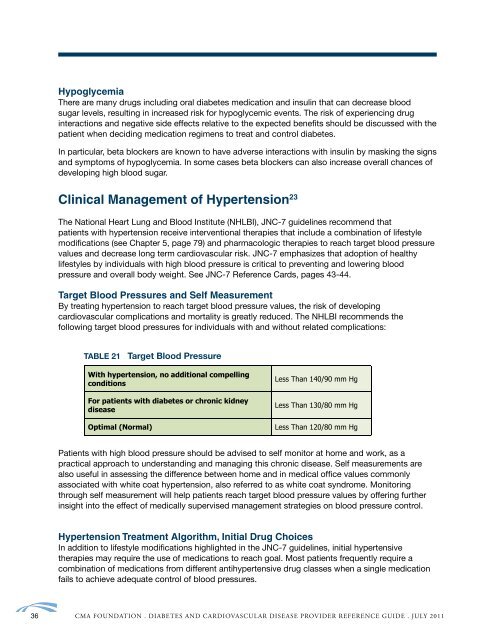Type 2 Diabetes Adult Outpatient Insulin Guidelines - CMA Foundation
Type 2 Diabetes Adult Outpatient Insulin Guidelines - CMA Foundation
Type 2 Diabetes Adult Outpatient Insulin Guidelines - CMA Foundation
Create successful ePaper yourself
Turn your PDF publications into a flip-book with our unique Google optimized e-Paper software.
Hypoglycemia<br />
There are many drugs including oral diabetes medication and insulin that can decrease blood<br />
sugar levels, resulting in increased risk for hypoglycemic events. The risk of experiencing drug<br />
interactions and negative side effects relative to the expected benefits should be discussed with the<br />
patient when deciding medication regimens to treat and control diabetes.<br />
In particular, beta blockers are known to have adverse interactions with insulin by masking the signs<br />
and symptoms of hypoglycemia. In some cases beta blockers can also increase overall chances of<br />
developing high blood sugar.<br />
Clinical Management of Hypertension 23<br />
The National Heart Lung and Blood Institute (NHLBI), JNC-7 guidelines recommend that<br />
patients with hypertension receive interventional therapies that include a combination of lifestyle<br />
modifications (see Chapter 5, page 79) and pharmacologic therapies to reach target blood pressure<br />
values and decrease long term cardiovascular risk. JNC-7 emphasizes that adoption of healthy<br />
lifestyles by individuals with high blood pressure is critical to preventing and lowering blood<br />
pressure and overall body weight. See JNC-7 Reference Cards, pages 43-44.<br />
Target Blood Pressures and Self Measurement<br />
By treating hypertension to reach target blood pressure values, the risk of developing<br />
cardiovascular complications and mortality is greatly reduced. The NHLBI recommends the<br />
following target blood pressures for individuals with and without related complications:<br />
Table 21: Target Blood Pressure<br />
TAbLe 21 Target blood Pressure<br />
With hypertension, no additional compelling<br />
conditions<br />
For patients with diabetes or chronic kidney<br />
disease<br />
Optimal (Normal)<br />
Less Than 140/90 mm Hg<br />
Less Than 130/80 mm Hg<br />
Less Than 120/80 mm Hg<br />
Patients with high blood pressure should be advised to self monitor at home and work, as a<br />
practical approach to understanding and managing this chronic disease. Self measurements are<br />
also useful in assessing the difference between home and in medical office values commonly<br />
associated with white coat hypertension, also referred to as white coat syndrome. Monitoring<br />
through self measurement will help patients reach target blood pressure values by offering further<br />
insight into the effect of medically supervised management strategies on blood pressure control.<br />
Hypertension Treatment Algorithm, Initial Drug Choices<br />
In addition to lifestyle modifications highlighted in the JNC-7 guidelines, initial hypertensive<br />
therapies may require the use of medications to reach goal. Most patients frequently require a<br />
combination of medications from different antihypertensive drug classes when a single medication<br />
fails to achieve adequate control of blood pressures.<br />
36 <strong>CMA</strong> FoundAtion . diAbetes And CArdiovAsCulAr diseAse Provider reFerenCe guide . july 2011


